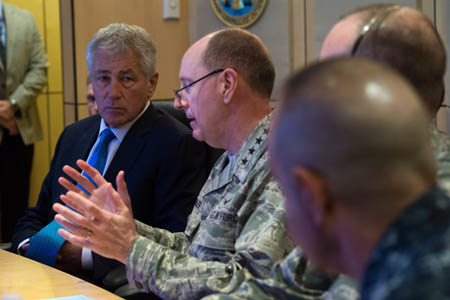 A comprehensive life-extension program for the B61 nuclear gravity bomb is essential to the US nuclear deterrent force, and “now is the time to get moving” on the project, said Gen. Robert Kehler, US Strategic Command boss. “For as far as we can see in the future, we are going to need the B61,” he said during a meeting with defense reporters in Washington, D.C., on July 24. “The B61 is an essential piece” of the US extended deterrent that protects US allies and partners, and is by no means Cold War “detritus,” as some have disparagingly called it, he said. The option of refreshing only the bomb’s essential electric components and deferring other updates would “increase the cost” ultimately, said Kehler. Instead, “it makes the most sense to do a comprehensive life-extension program” because it is ‘the most cost effective” option in the long term, he said. The B61 arms not only dual-capable US F-15Es and F-16s stationed in Europe, but also the B-2 stealth bomber, said Kehler. The F-35 is supposed to carry the B61, and Kehler said it would also be one of the nuclear weapons integrated on the future long-range-strike bomber.
A comprehensive life-extension program for the B61 nuclear gravity bomb is essential to the US nuclear deterrent force, and “now is the time to get moving” on the project, said Gen. Robert Kehler, US Strategic Command boss. “For as far as we can see in the future, we are going to need the B61,” he said during a meeting with defense reporters in Washington, D.C., on July 24. “The B61 is an essential piece” of the US extended deterrent that protects US allies and partners, and is by no means Cold War “detritus,” as some have disparagingly called it, he said. The option of refreshing only the bomb’s essential electric components and deferring other updates would “increase the cost” ultimately, said Kehler. Instead, “it makes the most sense to do a comprehensive life-extension program” because it is ‘the most cost effective” option in the long term, he said. The B61 arms not only dual-capable US F-15Es and F-16s stationed in Europe, but also the B-2 stealth bomber, said Kehler. The F-35 is supposed to carry the B61, and Kehler said it would also be one of the nuclear weapons integrated on the future long-range-strike bomber.
The U.S. military is maintaining a beefed-up presence in the Middle East, including fighters and air defense assets, following the U.S. strikes on Iranian nuclear facilities June 22 and subsequent retaliation by the Iranians against Al Udeid Air Base in Qatar.
